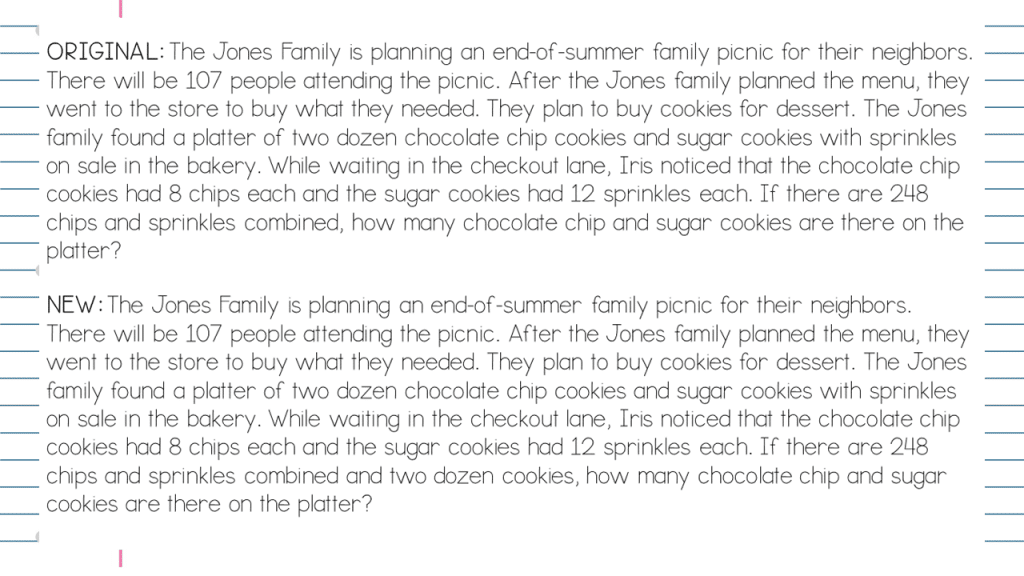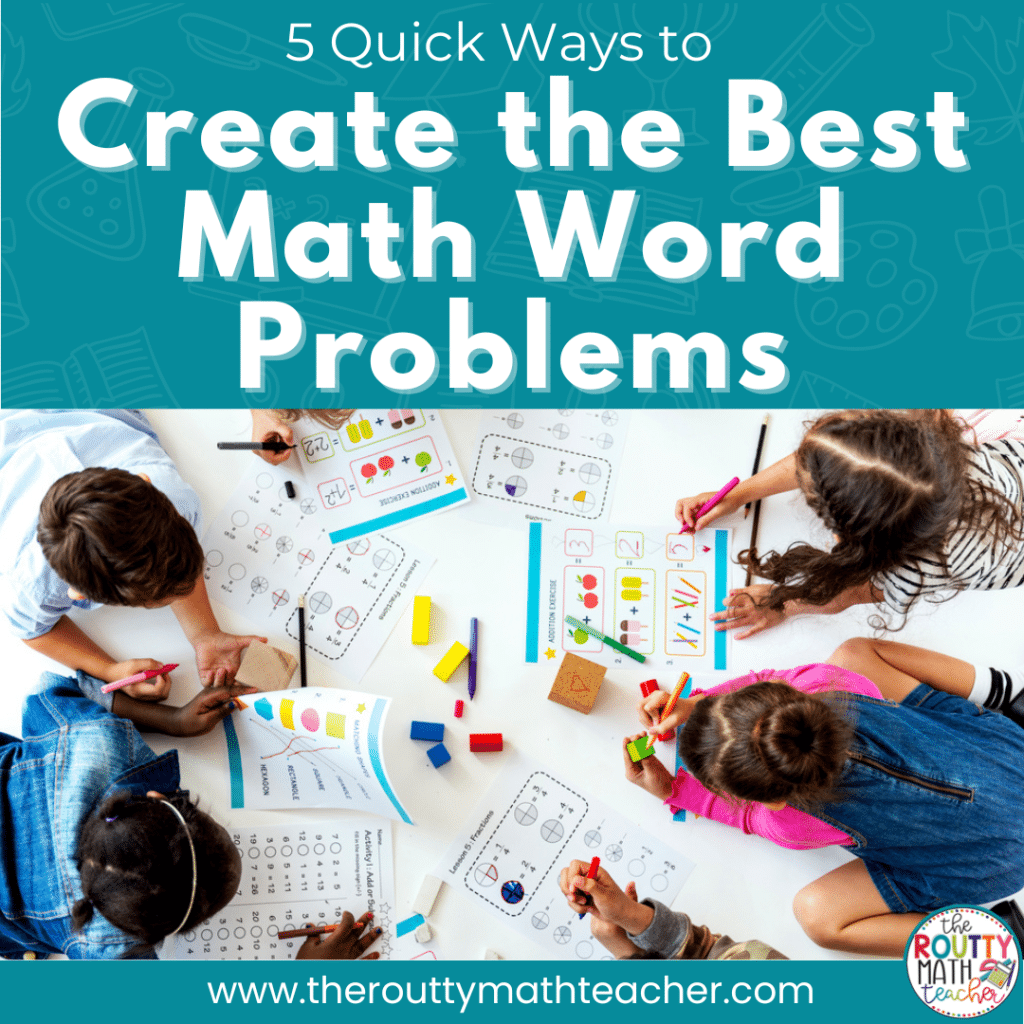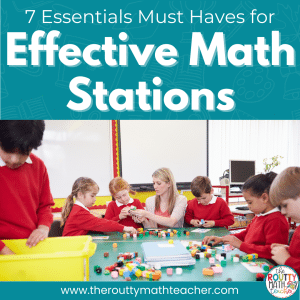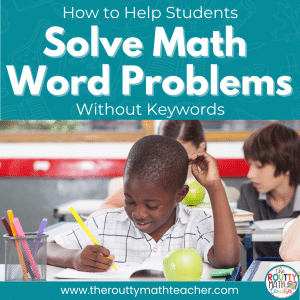Sometimes, it is difficult to find ready-made problem-solving tasks that match the content we’re teaching. In this post, I share five strategies to turn those boring math word problems into rich math word problems.
My students have gone home and I’m just sitting down to craft my math lessons for next week.
I look towards the window– the twinkle of the starlight makes me yawn.
After a long week and a few hours of grading papers, I’m ready to head home.
All I need are some rich math word problems to use with a football-themed multiplication and division game I created to wrap up our unit on whole number operations.
I look through all my resources and come up short.
As a last resort, I pull out our math textbook, find the correct lesson, and skim the page until I get to the end of the practice tasks.
I know you remember . . .
The Anatomy of Textbook Word Problems
There were usually three to five, often unrealistic, word problems at the end of every lesson just like the following task:
Sam raises chickens. On Saturday morning, he takes eggs to the local farmer’s market to sell. Before going to the farmer’s market, he collected 19 dozen brown eggs. How many eggs did Sam take to the Farmer’s market?
Textbook tasks, while better than nothing, are usually simple and follow whatever rule or formula reinforced by the lesson, but they don’t challenge students or reinforce the thinking needed to demonstrate success with a skill.
So what now? How do I find the rich math word problems my students need to be successful?
What is A Rich Math Task?
A rich math task possesses several characteristics:
- It is accessible to all students.
- It relates to the real world.
- It has multiple solution paths.
- It is discussion-worthy.
- It connects to the standards.
- It provides opportunities for extension.
Tasks that possess these characteristics (Source: Heinemann Blog), or at least some of them, give our students the greatest learning experiences.
But, where can you find these types of tasks?
How to Create Rich Math Word Problems
Problem-solving tasks can be difficult to find because they are not always included in the curricular resources available to teachers; however, using these strategies can help transform traditional math word problems into rich mathematical tasks.
1. Use a Familiar Context
To be successful, students must be able to visualize what’s happening in math word problems. This prevents them from relying on math keywords to know what to do. When the context of the task is something with which students are familiar, they can easily visualize the situation.
2. Ensure There are Multiple Solution Paths
One of the ways to make a task more accessible to learners is to open the task so there are multiple ways to solve the problem. The paths may lead to the same answer, but this allows students to choose a method comfortable for them. When considering how students may solve a problem, think about strategies such as draw a picture, make a table, and write an equation.
While not math word problems, this website has great examples of open problems you can try with your students. These tasks are also great springboards for ways to “open” a task you may want to use in the classroom.
3. Add Extra Information
As teachers, we’ve all seen students who go through a math problem and pick all the numbers to add, subtract, multiply, or divide. One way to help eliminate this problem is to add additional details and information to the task. This forces students to sift through the problem and determine exactly what’s needed to respond to the task.
4. Create a Multi-Step Problem
Many students are used to using one operation to complete a problem. Creating multi-step problems forces them to attend to the details of the task, visualize the scenario, and determine in what order to complete the operations needed to solve the problem. Multi-step tasks create instant opportunities for a challenge because students have to understand the task to know what to do and when to do it.
5. Change the Values or Conditions
This is a strategy I use often when creating tasks for different grade levels. Using smaller/larger values or adding/removing certain conditions can also change the level of a task.
How to Transform a Traditional Math Word Problem into a Rich Math Word Problem
Let’s look at a couple of examples that incorporate some of the strategies above.
Example A
Let’s take a look at a task that incorporates the first four tips.
![[Insert Example 1 here; Alt text: This is an example of how to create rich math word problems.]](https://www.therouttymathteacher.com/wp-content/uploads/2021/10/Example-1-min-1024x576.png)
Can you see the difference between the original task and the new task?
Which task is more engaging for students?
As you can see from the task above, there is a lot of information to which students must attend. They will need to understand the task before they attempt to solve the problem.
Example B
Let’s take a look at another task.

Notice there is an added condition on the new task.
The original task has multiple answers; however, by adding the number of cookies to the second task, the list of possible responses narrows to only one.
While using the original task provides more access for students, adding the condition offers more of a challenge to students.
Both tasks will help students build their problem-solving toolboxes, but the second task pushes the level up encouraging students to persevere to solve the problem.
Next Steps
Finding good math word problems is difficult, but there are ways to transform your existing problems, like those found in textbooks and supplemental resource materials, into rich math word problems.
Next time you want to increase the rigor in your classroom when working on math word problems, try using the tips above to help. You can even grab a niffy download of the tips to tuck into your lesson planning book to use as a reference tool using the form below.
Sound Off!
Which tip do you think is most beneficial for your students? Respond in the comments below.
Reference:
Heinemann Blog at https://blog.heinemann.com/6-characteristics-rich-math-tasks








2 Responses
Math word problems are very important part of learning mathemathics at school. Creating the rich math word problems can help students a lot, I have no doubt about that. These are the tasks that really help them to be able to apply their math skills in their future everyday lifes.
Absolutely! I agree 100%!